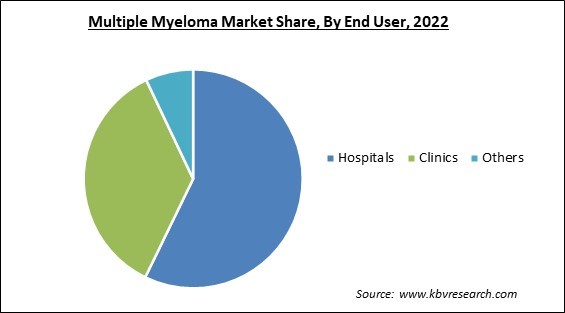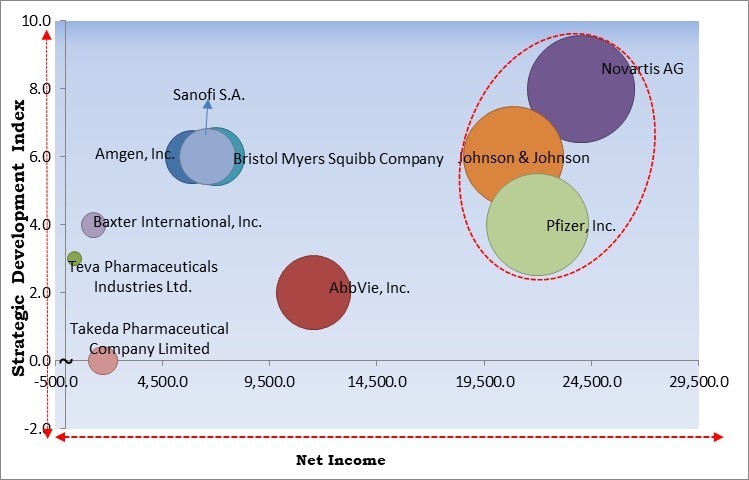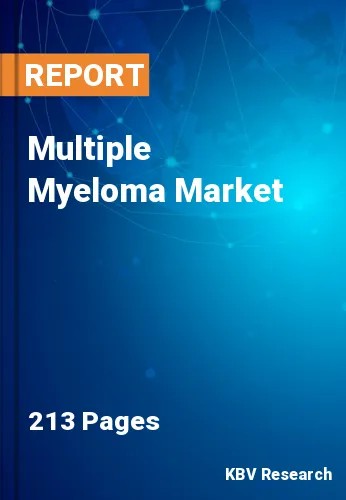The Global Multiple Myeloma Market size is expected to reach $37.5 billion by 2029, rising at a market growth of 9.8% CAGR during the forecast period.
Multiple myeloma or plasma cell cancer is a disease. The immune system is significantly dependent on healthy plasma cells, which are located in the bone marrow. In order to combat infections and other diseases, the immune system is composed of various cell types. T cells and B cells are two of the most common types of lymphocytes (lymph cells) in the immune system. The lymph nodes, bone marrow, intestines, and circulation are just a few of the organs where lymphocytes can be found.

B cells develop into plasma cells due to the immune system's response to an infection. Antibodies, also known as immunoglobulins, are produced by plasma cells and aid the body's defense against pathogens. Bone marrow contains the majority of plasma cells. Soft tissue found inside bones is called bone marrow. Other blood cells, including red, white, and platelets, are also found in the normal bone marrow and plasma cells.
Multiple myeloma is the term used to describe plasma cells that have developed malignancy and are growing uncontrollably. Monoclonal immunoglobulin, or M-protein, M-spike, or paraprotein, is an aberrant protein (antibody) produced by plasma cells. Immunoglobulins made by healthy plasma cells can recognize and eliminate germs, which is helpful in the fight against infections.
However, cancerous plasma cells gather in the bone marrow of patients with multiple myeloma and destroy healthy blood cells. As a result, the body produces paraproteins, aberrant proteins that can accumulate and harm tissues and organs. Multiple myeloma has several side effects, including frequent infections, anemia, bone pain, and renal problems. Targeted therapy, chemotherapy, radiation therapy, and stem cell transplantation are available as alternatives for treatment.
Since R&D operations were substantially hampered by the pandemic, developing novel medicines and treatments for multiple myeloma also slowed considerably. Moreover, the Blood Cancer Journal reported in December 2021 that fewer new instances of multiple myeloma were identified in 2020 in comparison with 2019 and that the survival rate for those cases declined concurrently. Patients with multiple myeloma had a higher mortality rate and COVID-19 infection risk in 2020. Therefore, the pandemic had a detrimental effect on the multiple myeloma market.
Along with care practices, governments and organizations are also extending support for other current problems in provider relations include fee schedules & reimbursement, sites of care, route of drug administration, and politics as well as other network issues. These problems are pushing oncology practices into more payer-provider collaborative initiatives, including accepting patient-care medical homes, where primary care doctors coordinate care with experts and other specialists and creating affordable oncology healthcare institutions in both the commercial and Medicare/Medicaid spaces. Hence, the increasing support of governments is projected to increase demand for treatments or medications for multiple myeloma, thereby fueling market expansion.
The rising incidence of several types of blood malignancies, including multiple myeloma, is one of the major market-driving factors. Although MM is regarded as a more uncommon cancer kind, there are a sizable number of cases of cancer worldwide, and the demand for effective and cutting-edge therapies is rising. Patients frequently experience better and more favorable clinical results when effective and cutting-edge therapies are administered. This is crucial because current trends point to an increase in the prevalence of MM around the globe. In addition, as a result of ongoing R&D, treatment has advanced, necessitating more complex medicines to improve prognosis.
Common side effects of Kyprolis include fatigue, a low blood cell count and blood platelet levels, diarrhea, constipation, nausea, shortness of breath, fever, swelling of the extremities, upper respiratory tract infection, bronchitis, and pneumonia. Additionally, certain side effects of the drug include low blood potassium, high blood sugar, low blood calcium, muscle spasms, numbness and tingling in the extremities, and high blood pressure. In addition, radiation therapy can cause adverse effects such as fatigue, irritation of the skin, nausea, diarrhea, loss of hair in the treatment area, infertility, higher risk of infection, loss of appetite, increased risk of subsequent cancer, and harm to organs located near the treatment area.
Based on drug type, the multiple myeloma market is categorized into chemotherapy, protease inhibitors, monoclonal antibody, and others. The monoclonal antibodies segment procured a considerable growth rate in the multiple myeloma market in 2022. The therapeutic options for multiple myeloma have radically changed due to the recent introduction of monoclonal antibodies (mAbs). The effectiveness of elotuzumab and daratumumab in relapsed/refractory patients has sparked much interest in mAbs for this condition.

On the basis of end user, the multiple myeloma market is divided into hospitals, clinics, and others. The hospitals segment acquired the largest revenue share in the multiple myeloma market in 2022. The hospital segment is growing due to factors including an increase in patient admissions, a rise in the prevalence of multiple myeloma, and the availability of qualified medical staff in these facilities that enable improved patient services. The fact that the medications used in treatment can be routinely prescribed and given in hospital settings accounts for a significant portion of this segment's dominance.
Based on disease type, the multiple myeloma market is segmented into active multiple myeloma and smoldering multiple myeloma. The smoldering multiple myeloma segment garnered a remarkable growth rate in the multiple myeloma market in 2022. The growth of the segment is owed to the increasing awareness of the disease. It may take years for smoldering multiple myeloma to develop into an active form. As a result, some individuals with this syndrome never experience active MM. Healthcare professionals’ control SMM by watching for symptoms that it's turning into active multiple myeloma.
| Report Attribute | Details |
|---|---|
| Market size value in 2023 | USD 19.8 Billion |
| Market size forecast in 2029 | USD 37.5 Billion |
| Base Year | 2022 |
| Historical Period | 2019 to 2021 |
| Forecast Period | 2023 to 2029 |
| Revenue Growth Rate | CAGR of 9.8% from 2023 to 2029 |
| Number of Pages | 213 |
| Number of Table | 354 |
| Report coverage | Market Trends, Revenue Estimation and Forecast, Segmentation Analysis, Regional and Country Breakdown, Competitive Landscape, Companies Strategic Developments, Company Profiling |
| Segments covered | Drug Type, Disease Type, End User, Region |
| Country scope | US, Canada, Mexico, Germany, UK, France, Russia, Spain, Italy, China, Japan, India, South Korea, Singapore, Malaysia, Brazil, Argentina, UAE, Saudi Arabia, South Africa, Nigeria |
| Growth Drivers |
|
| Restraints |
|
On the basis of region, the multiple myeloma market is analyzed across North America, Europe, Asia Pacific, and LAMEA. The North America segment procured the highest revenue share in the multiple myeloma market in 2022. Due to the strong presence of key competitors and the rise in multiple myeloma drug launches and product approvals, the North American multiple myeloma market is predicted to expand considerably over the forecast period. Moreover, the market is anticipated to develop because of the rising prevalence of multiple myeloma. For instance, the American Cancer Society forecasted that by 2023, 35,730 incidences of multiple myeloma would have been discovered in the United States.
Free Valuable Insights: Global Multiple Myeloma Market size to reach USD 37.5 Billion by 2029

The major strategies followed by the market participants are Acquisitions. Based on the Analysis presented in the Cardinal matrix; Novartis AG, Johnson & Johnson, and Pfizer, Inc. are the forerunners in the Multiple Myeloma Market. Companies such as Amgen, Inc., Sanofi S.A., and Bristol Myers Squibb Company are some of the key innovators in Multiple Myeloma Market.
The market research report covers the analysis of key stake holders of the market. Key companies profiled in the report include Novartis AG, Bristol Myers Squibb Company, Amgen, Inc., AbbVie, Inc., Sanofi S.A., Johnson & Johnson, Baxter International, Inc., Takeda Pharmaceutical Company Limited, Teva Pharmaceuticals Industries Ltd., and Pfizer, Inc.
By End User
By Disease Type
By Drug Type
By Geography
The Market size is projected to reach USD 37.5 billion by 2029.
Increasing government support initiatives worldwide are driving the Market in coming years, however, Lack of permanent solutions and side effects of many existing treatments restraints the growth of the Market.
Novartis AG, Bristol Myers Squibb Company, Amgen, Inc., AbbVie, Inc., Sanofi S.A., Johnson & Johnson, Baxter International, Inc., Takeda Pharmaceutical Company Limited, Teva Pharmaceuticals Industries Ltd., and Pfizer, Inc.
The Active Multiple Myeloma segment acquired maximum revenue share in the Global Multiple Myeloma Market by Disease Type in 2022 thereby, achieving a market value of $29.6 billion by 2029.
The North America market dominated the Market by Region in 2022, and would continue to be a dominant market till 2029; thereby, achieving a market value of $14.3 billion by 2029.
Our team of dedicated experts can provide you with attractive expansion opportunities for your business.

